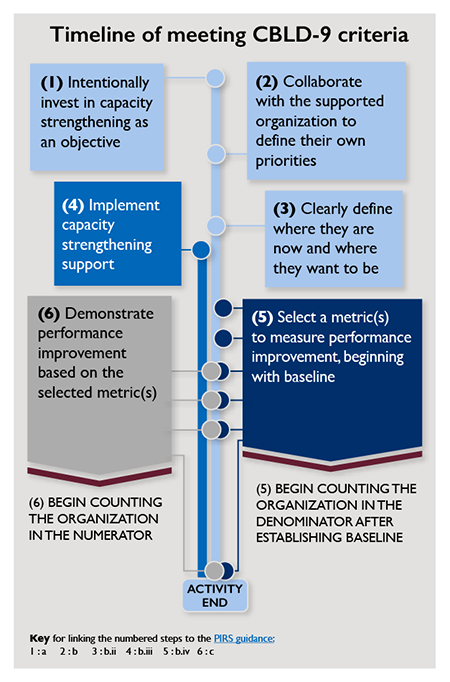Measuring the results of USAID’s local capacity strengthening programming is essential for understanding what works and improving programming over time.
Principle 3 of the Local Capacity Strengthening (LCS) Policy, “Plan for and measure performance in collaboration with local partners,” highlights that measurement is important not just for learning and accountability, but as a tool for partnership with local actors. Planning for measurement of LCS programming is an opportunity to engage local partners and other stakeholders in defining their own priorities and determining what success looks like.
Additionally, in support of Localization, USAID is monitoring progress on which programs utilize “good practices” that advance locally led development across the project life cycle. “Using demand driven capacity strengthening approaches” in line with the LCS Policy is “good practice” 5. Review the Performance Indicator Reference Sheets for LCS good practice.
LCS performance measurement can take a variety of forms, including (but not limited to) three Standard Foreign Assistance indicators (described below) and stakeholder feedback processes.
Local Capacity Strengthening Standard Indicators

CBLD-9 Indicator: CBLD-9 is defined as “Percent of USG-assisted organizations with improved performance.” The unit of measure is an organization. Importantly, this indicator captures performance improvement - not improvements in latent capacity or delivery of capacity strengthening interventions. As such, it requires a quantitative or qualitative metric by which an organization’s performance improvement is assessed, and this metric should reflect each organization’s unique performance improvement goals. Additional resources on CBLD-9 are found here:
- CBLD-9 Performance Indicator Reference Sheet (FY24) (PIRS): The PIRS provides detail on the exact definition of the indicator, numerator and denominator, criteria for counting organizations under this indicator, and organization type disaggregates.
- CBLD-9 Training Slide Deck: This training breaks down the components and criteria of CBLD-9, explaining each in detail.
- CBLD-9 frequently asked questions (FAQs) (Updated 2023): This resource addresses many common misperceptions and points of confusion regarding CBLD-9.
- CBLD-9 Measurement Guide (2021): This guide provides examples of capacity strengthening activities and their measurement approaches, organized by sector. This is a good starting point for Operating Units and implementing partners in developing a measurement plan in activities featuring organizational performance improvement.
- CBLD-9 Target Setting Guidance (2023): This document expands on USAID target-setting guidance by outlining considerations specific to CBLD-9.
- Worksheet for implementing partners (2020): This worksheet provides a template for implementing partners to ensure counted organizations meet each of the CBLD-9 criteria.
- CBLD-9 Guidance for the Education Sector (2024): This document provides guidance for USAID operating units and implementing partners on using the Capacity Building-9 (CBLD-9) indicator in education sector programming.
- CBLD-9 Performance Indicator Reference Sheet in Spanish (FY23 Version)
- Demand Driven Capacity Strengthening: A CBLD-9 Case Study from Paraguay: This case study describes how CBLD-9 prompted an implementing partner to update their approach to better respond to supported organizations’ priorities.
CBLD-11 Indicator: CBLD-11 is defined as “Number of organizations pursuing their own performance improvement priorities with USG capacity strengthening support.” This indicator is the output-level counterpart to CBLD-9. Organizational performance improvement takes time, and outcome-level results often cannot be shown within the first few years of an activity. CBLD-11 enables partners and OUs to demonstrate work on demand-driven organizational capacity strengthening programming before performance improvement is visible.
- CBLD-11 Performance Indicator Reference Sheet (FY24) (PIRS)
CBLD-10 Indicator: CBLD-10 is defined as “Value ($) of non-donor resources mobilized for local development priorities.” Mobilization of financial or in-kind resources is one measure of a local system's capacity to sustain desired development outcomes. Both cash and in-kind resources from any individual or organization (excluding bilateral and multilateral development agencies) can be counted under CBLD-10.
- CBLD-10 Performance Indicator Reference Sheet (FY24) (PIRS)
- Unleashing Local Assets: Tips for Measuring Local Resources - This resource provides suggestions for quantifying the value of labor, equipment, and other in-kind resources, as well as tips for sourcing and verifying these data.
- CBLD-10 Worksheet
- CBLD-10 FAQs
- CBLD-10 Performance Indicator Reference Sheet in Spanish (FY23 Version)
Choosing the Right Tool for Local Capacity Strengthening
It is a common misperception that activities must use an index tool (for example, the Organizational Performance Index (OPI) or Organizational Capacity Assessment (OCA)) to identify areas for capacity strengthening and measure performance improvement over time. However, identifying areas for capacity strengthening (capacity action planning) and measuring performance improvement are distinct processes, and rarely does one tool meet both needs.
To help you choose the right type of tool to use in capacity strengthening, review the Guide for Distinguishing Tools. This document offers guidance to assist USAID staff and partners to select which tools are most useful for performance measurement, capacity action planning, and risk mitigation.
Stakeholder Feedback
Collecting stakeholder feedback is a great way to understand the perceptions of supported local actors regarding the relevance and quality of capacity strengthening programming. It can provide information that cannot be captured through standard indicators.
- Tips on planning for, collecting, and using stakeholder feedback breaks the stakeholder feedback process into five easy-to-understand steps, with example strategies and questions.
- The How-to guide on Accountability and Feedback Plans, developed by USAID’s Partnerships Incubator, provides tips for thinking about the who, what, and how of stakeholder feedback.
